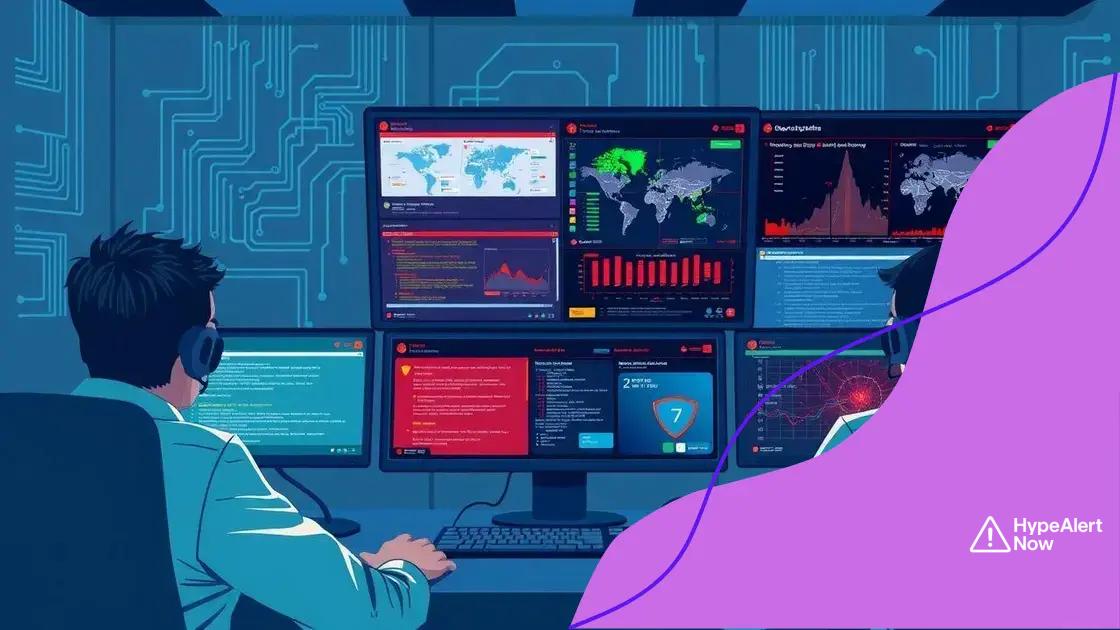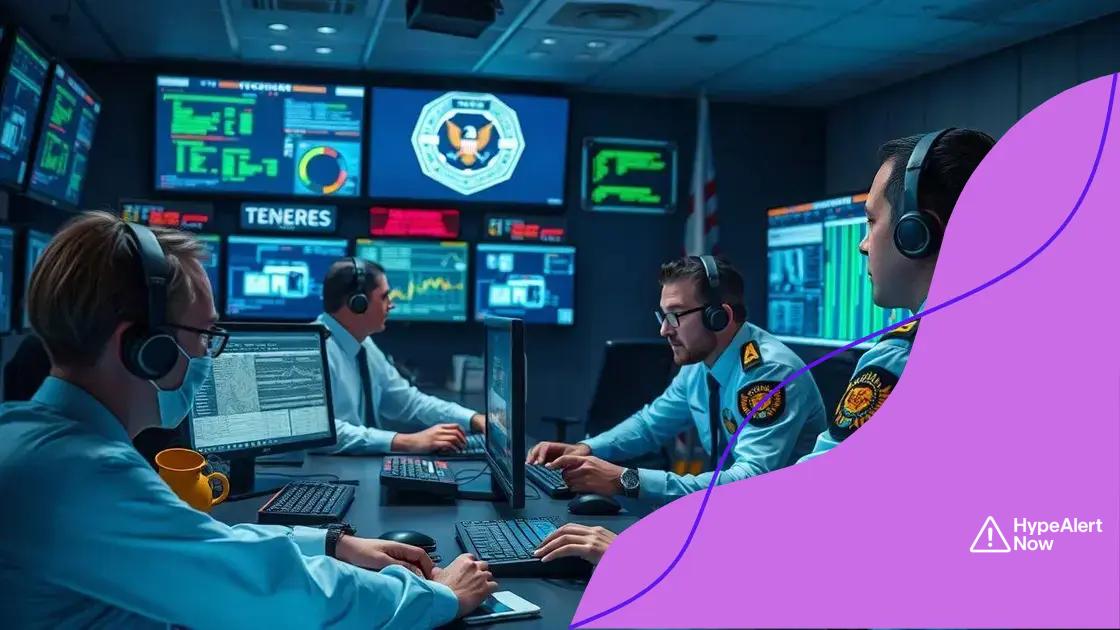Cybersecurity threats and government responses: what to know

Cybersecurity threats encompass malware, phishing, and DDoS attacks, which require proactive management through strong security policies, regular updates, and employee training to protect sensitive data effectively.
Cybersecurity threats and government responses have grown in urgency as our reliance on technology increases. With each breach, questions arise: how secure is our data? Have you ever wondered what steps governments are taking to protect us?
Understanding cybersecurity threats
Understanding cybersecurity threats is crucial in today’s digital age. Every day, individuals and organizations face various risks from malicious actors. These threats can lead to serious consequences, including financial loss and data breaches. Let’s dive deeper into what these threats are.
Types of Cybersecurity Threats
There are several common types of cybersecurity threats that everyone should be aware of:
- Malware: This includes viruses, worms, and Trojan horses that can infect your devices.
- Phishing: A tactic where attackers deceive individuals into providing sensitive information.
- DDoS Attacks: Overloading a system with traffic to make it unavailable.
- Insider Threats: Risks that originate from within the organization, often unintentional.
Recognizing these threats is the first step toward safeguarding your information. Awareness helps you take precautionary measures. For example, ensuring your software is always up-to-date can significantly reduce the risk of malware affecting your systems.
Real-World Implications
Cybersecurity threats can have real-world implications that extend beyond the digital realm. When a company’s data is compromised, it often results in loss of trust from customers and partners. This can lead to significant reputational damage. Moreover, recovering from a breach often involves costly measures. Investments in cybersecurity are not just expenses; they are essential protections for both individuals and businesses.
As technology evolves, so do the tactics of cybercriminals. Keeping an ongoing education about these threats is crucial for everyone, not just IT professionals. By understanding the landscape of cybersecurity threats, you can better prepare yourself and your organization to handle potential risks effectively.
Types of cybersecurity threats
Understanding the different types of cybersecurity threats is vital for anyone using digital technology today. These threats can target personal information, company data, or even critical infrastructure. Recognizing these threats can help in developing effective defenses against them.
Malware and Its Variants
Malware is one of the most widespread threats. It refers to any software intentionally designed to cause damage to devices or networks. Its various types include:
- Viruses: These can replicate themselves and spread to other systems.
- Worms: Unlike viruses, worms can self-replicate and spread without user intervention.
- Trojan Horses: This type disguises itself as legitimate software but can harm your system.
Staying informed about malware can reduce your chances of infection. Always using reliable antivirus software and avoiding suspicious downloads are key strategies.
Phishing Attacks
Another common type of threat is phishing. Phishing attacks are designed to trick users into providing sensitive information, like passwords or credit card numbers. Attackers often use emails or fake websites that look legitimate to deceive users.
Be cautious with any unexpected messages requesting personal information. Common signs of phishing include:
- Urgent requests for sensitive information.
- Misspellings in sender addresses or websites.
- A generic greeting instead of your name.
Awareness is the key to avoiding these dangerous scams. Always verify the sender before clicking on links or providing information.
DDoS Attacks
A DDoS (Distributed Denial of Service) attack overwhelms a network by flooding it with excessive traffic. This makes services unavailable to legitimate users. These attacks can target websites, applications, or entire networks.
To help mitigate DDoS threats, organizations might use techniques such as:
- Traffic analysis to recognize and filter malicious traffic.
- Rate limiting to control the flow of incoming requests.
- Building redundancy within their systems to handle increased loads.
Being aware of these types of cybersecurity threats can empower individuals and organizations to take proactive steps to defend their information and systems.
Government responses to cybersecurity threats

Government responses to cybersecurity threats are essential for protecting national interests and ensuring public safety. As cyber attacks increase, governments worldwide develop strategies to address these challenges effectively. Understanding these responses can help organizations and citizens stay informed.
Legislation and Regulations
One of the primary ways governments respond to cybersecurity threats is through legislation. Laws are enacted to ensure organizations and individuals take necessary precautions to protect their data. Key regulations include:
- GDPR: The General Data Protection Regulation imposes strict rules on data protection and privacy for individuals within the European Union.
- HIPAA: The Health Insurance Portability and Accountability Act safeguards sensitive patient information in the healthcare sector.
- FERPA: The Family Educational Rights and Privacy Act protects student education records in the U.S.
These laws create accountability for organizations and define legal consequences for failing to protect sensitive data.
Funding and Resources
Governments allocate funding to enhance cybersecurity measures. This includes providing resources for developing robust defenses against cyber threats. For instance, many nations have established cybersecurity agencies that focus on:
- Conducting research on emerging cyber threats.
- Developing national cybersecurity strategies.
- Offering support to local businesses in enhancing their cybersecurity posture.
By investing in cybersecurity infrastructures, governments aim to create a safer digital environment for everyone.
Collaboration between government and private sectors is crucial in enhancing cybersecurity measures. Public-private partnerships facilitate knowledge sharing and promote the development of innovative security solutions. When governments and businesses work together, they can respond more effectively to cybersecurity threats. Furthermore, this collaboration often leads to the establishment of best practices across industries.
The growing landscape of digital threats means that government responses must continuously evolve. Adapting laws, funding initiatives, and collaboration efforts are all part of a comprehensive approach to tackling cybersecurity threats on a global scale.
Best practices for individuals and organizations
Implementing best practices for cybersecurity is essential for both individuals and organizations to protect sensitive data and maintain a secure digital environment. Adopting these practices can significantly reduce vulnerabilities to cyber threats.
Regular Software Updates
One fundamental practice is to keep all software up-to-date. Software developers frequently release updates to address security vulnerabilities. Failing to install these updates can leave systems exposed. Regularly updating your operating system, applications, and antivirus programs is vital for maintaining security.
Strong Password Policies
Another critical practice is establishing strong password policies. This includes using passwords that are:
- Unique: Avoid reusing passwords across different accounts.
- Complex: Use a mix of upper and lower case letters, numbers, and special characters.
- Two-factor authentication: Enable this feature whenever possible to add an extra layer of security.
Implementing strong passwords and using password managers to store them can enhance overall security.
Employee Training and Awareness
For organizations, training employees on cybersecurity awareness is crucial. Employees should be educated on common threats such as phishing attacks. Regular training sessions can help staff recognize suspicious activity and respond appropriately. Encouraging a culture of security awareness enables organizations to mitigate risks more effectively.
Additionally, involving employees in security audits and drills can prepare them for real-world scenarios. Such practices can foster a proactive stance towards cybersecurity across the organization.
Regular Backups
Regularly backing up data is another essential best practice. Creating backups ensures that critical information is not lost due to cyber attacks or system failures. Organizations should implement a systematic backup schedule, ensuring that backups are stored securely and tested periodically.
By following these best practices, both individuals and organizations can establish a strong defensive posture against cybersecurity threats. Adopting a proactive approach not only protects sensitive information but also builds trust among clients and stakeholders.
Future of cybersecurity threat management
The future of cybersecurity threat management is rapidly evolving, driven by technological advancements and increasing threats. As cyber threats become more sophisticated, organizations must adapt their strategies to stay one step ahead. This evolution involves multiple components that are crucial for effective security management.
Artificial Intelligence and Machine Learning
One significant trend is the integration of artificial intelligence (AI) and machine learning into cybersecurity efforts. These technologies can analyze vast amounts of data and identify patterns that humans may overlook. By automating threat detection, AI can help organizations respond to incidents more quickly. As AI evolves, it will become better at predicting threats before they materialize.
Zero-Trust Security Models
An emerging approach to security is the zero-trust model. This model assumes that threats may already exist inside the network. Therefore, verification is required from everyone trying to access resources, regardless of their location. Key principles of zero-trust include:
- Least privilege access: Ensuring users have only the access they need.
- Continuous verification: Regularly checking users and devices for authenticity.
- Micro-segmentation: Breaking the network into smaller, isolated segments to limit breaches.
Implementing a zero-trust model can improve an organization’s ability to manage and mitigate potential threats.
Cloud Security Innovations
As more businesses move to cloud-based environments, ensuring robust cloud security is essential. Future strategies will likely focus on enhancing visibility, control, and compliance in the cloud. Solutions might include:
- Cloud access security brokers: Tools that help manage data security policies.
- Encryption: Protecting cloud-stored data with advanced encryption techniques.
- Multi-cloud strategies: Using multiple cloud providers to distribute risk.
These innovations will be vital for safeguarding data and applications hosted in the cloud.
The future of managing cybersecurity threats will also involve increased collaboration between industries and public sectors. Sharing threat intelligence can enhance awareness and preparedness. By working together, organizations can create a more resilient cybersecurity landscape.
In conclusion, managing cybersecurity threats is essential for ensuring the safety of individuals and organizations in our increasingly digital world. With the rise of advanced technologies like AI and machine learning, as well as new security models such as zero-trust, the way we approach cybersecurity is changing. As threats evolve, so must our strategies. By prioritizing best practices, fostering collaboration, and investing in innovative solutions, we can build a safer digital future for everyone. Staying proactive and informed is key to overcoming the challenges in cybersecurity.
FAQ – Frequently Asked Questions about Cybersecurity Threats and Management
What are the main types of cybersecurity threats?
The main types include malware, phishing attacks, DDoS attacks, and insider threats, each targeting systems in different ways.
How can I protect my organization from cyber threats?
Implementing strong passwords, regular software updates, employee training, and backup solutions are key methods to protect against cyber threats.
What is the zero-trust security model?
The zero-trust model requires verification from everyone trying to access resources, assuming threats may already exist within the network.
Why is collaboration important in cybersecurity?
Collaboration allows organizations to share threat intelligence and resources, enhancing overall security and resilience against attacks.
